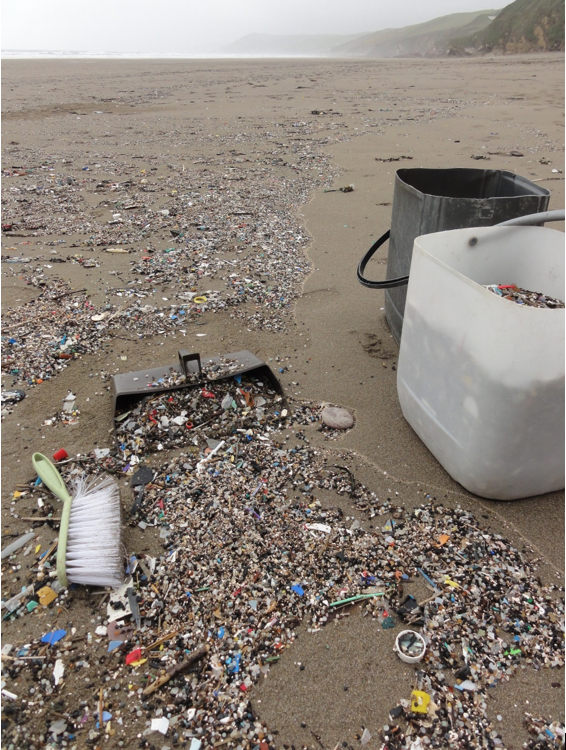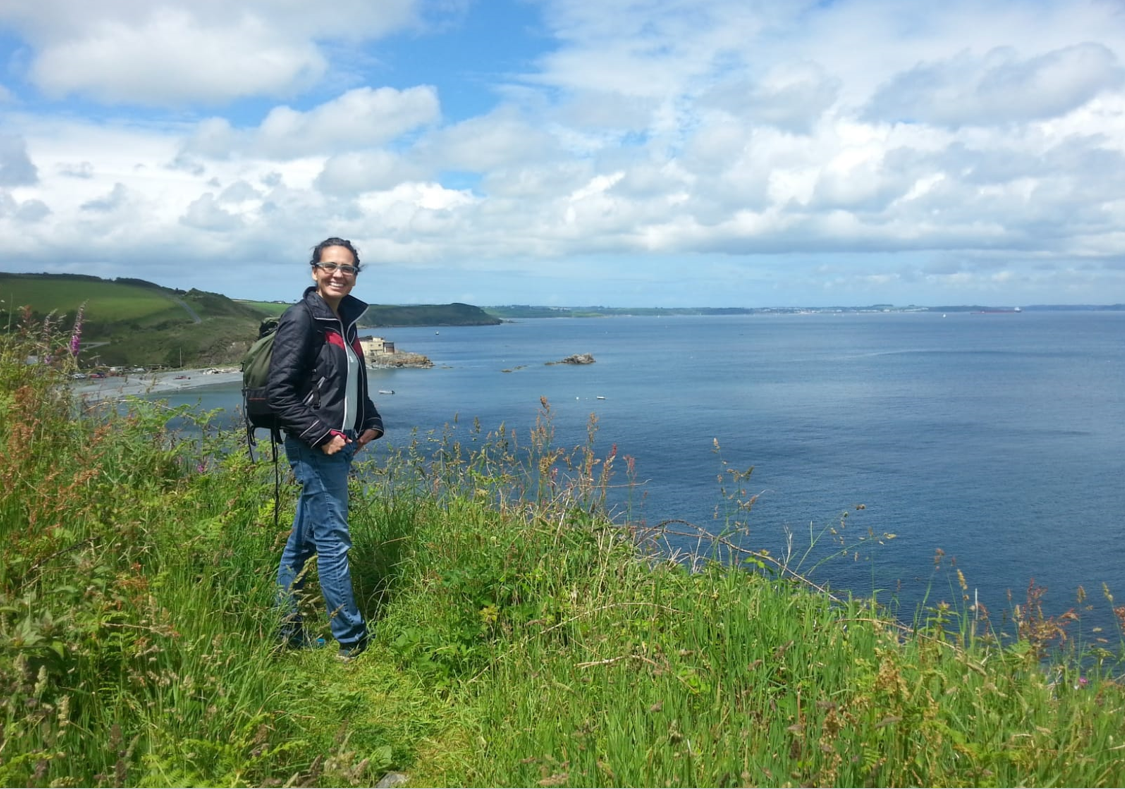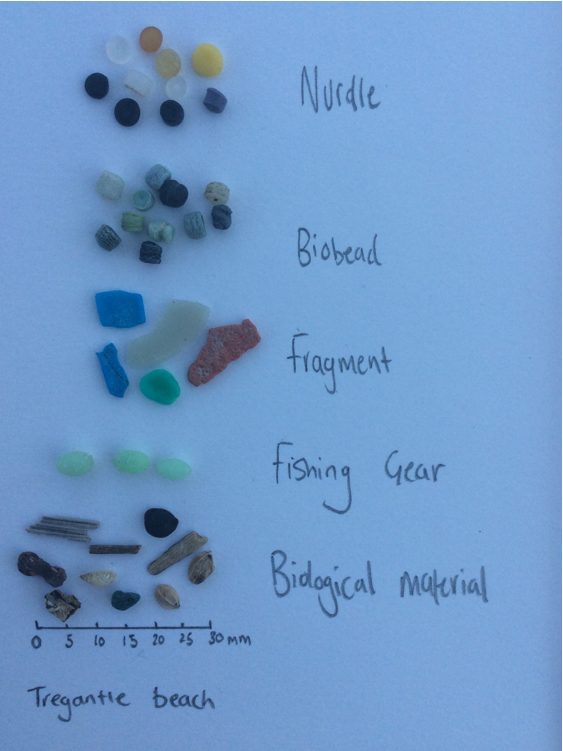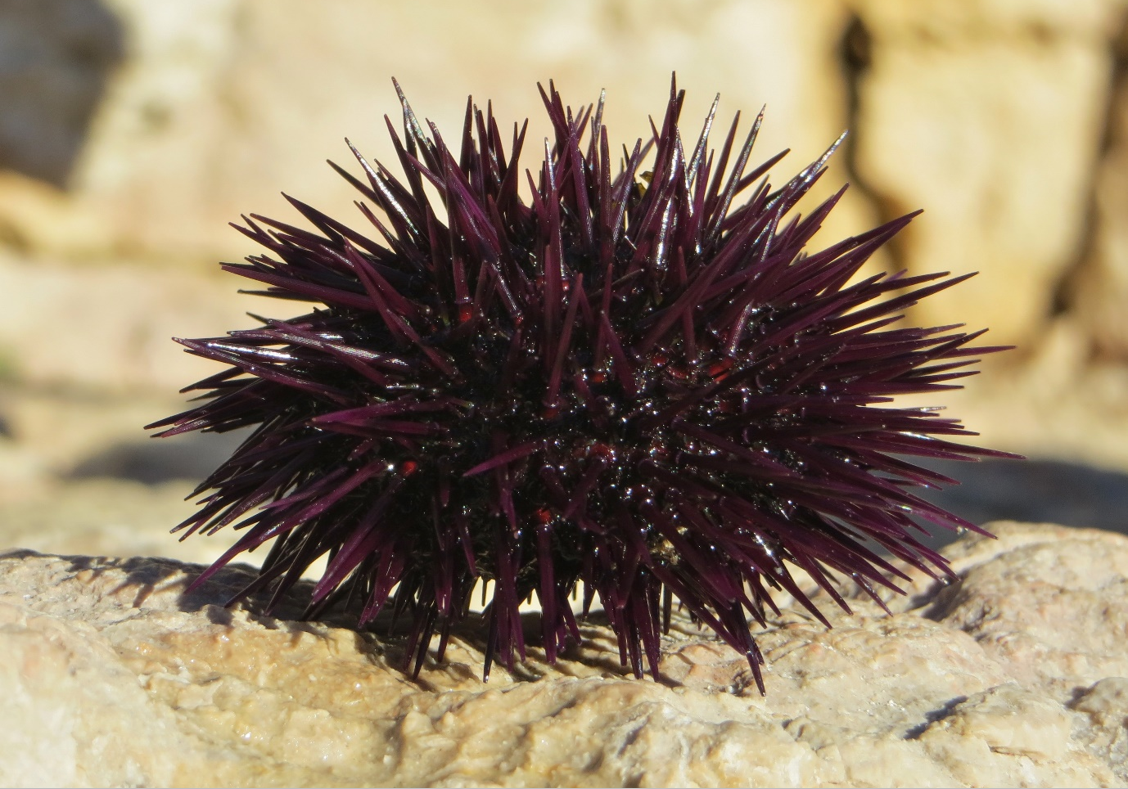- Chemicals found both in new plastics and those washed up on a U.K. beach caused deformities in sea urchin larvae, according to a new study in the journal Environmental Pollution.
- Sea urchin larvae raised in water tainted by chemicals found in plastics showed serious deformities; plastics that had never been chemically treated did not cause deformities.
- Chemicals are added to some plastics to enhance their properties, while plastics at sea can accumulate and concentrate chemicals already polluting the oceans.
- Researchers say more needs to be done to prevent plastics from reaching the ocean.
A lone figure kneels at the high-tide line of Tregantle Beach. A 2-kilometer (1.2-mile) sweep of golden sands that hugs the coast of Cornwall in southwest England, Tregantle is bound on one side by sloping cliffs and on the other by breaking waves, a few hardy surfers bobbing around in the foam like sleek black seals. The figure gently sweeps up sand with a dustpan and brush and tips it into a mesh office bin, from where much of the sand promptly runs out.
The act of sweeping this idyllic beach with a dustpan and brush may seem like insanity until you look closer still. While the sand drains out of the mesh bin, something remains. Plastic. Colored scraps, large and small, lie mixed with the sand all the way along this beach, as they do on many beaches across the globe. Some of these plastic fragments broke off from trash washed out to sea; others are floating filters or “biobeads” used to treat sewage water; and yet more are “nurdles,” the tiny building blocks of industrial plastics, each about the size of a lentil and notoriously prone to spilling.

The man patiently cleaning Tregantle Beach is Rob Arnold, a local artist who has been collecting plastics here for about seven years and turning them into sculptures.
“I go to Tregantle probably once a month,” Arnold says. “Every time I will see plastic washed up.”
But every now and then the pollution is so bad even Arnold is shocked. Describing the aftermath of a storm, he told Mongabay “I could hardly believe what my eyes were witnessing. The main stretch of the beach that is normally fairly clear of microplastics was thick with them … Even the rocks were smothered in nurdles and plastic fragments. I thought, ‘Oh my god, what have we done!’”

While Arnold turns most of the plastic he collects into art to raise awareness, not all his finds are destined for galleries: some he sends to a lab in Italy, to help scientists understand the hidden effects of plastics on ocean life. A scientific paper in Environmental Pollution used some of Arnold’s sweepings from Tregantle Beach to investigate the impacts of microplastics on purple sea urchins (Paracentrotus lividus). The scientific team, headed by Eva Jimenez-Guri, a developmental biologist from Spain based at the University of Exeter, U.K., looked at how chemicals from plastics affect the development of sea urchin larvae.
“We know that lots of animals have been found with plastic particles in their guts. Some to an extent where they have died because of their guts being blocked,” Jimenez-Guri tells Mongabay. But, she wondered, does plastic have impacts beyond physical clogging? Could it also harm marine life in more insidious ways?
The answer, she found, was yes. Her team discovered that chemicals found in plastics “cause extreme developmental defects to sea urchins,” she notes.

Plastics have properties that cause certain pollutants to bind to them. When environmental conditions change, those contaminants can be released. This means that as plastics move and accumulate in the oceans, they may be moving and concentrating chemicals with them.
The scientists focused on four types of plastic: nurdles and biobeads collected from Tregantle Beach, new polyvinyl chloride (PVC) pellets that had chemicals added to them as they were formed, and “virgin” polyethylene plastic lacking any added chemicals.

Jimenez-Guri and her team soaked the plastics in salt water for two days. After removing the plastics, the scientists added sea urchin embryos and larvae to the same water. After just 48 hours, the sea urchins showed striking deformities, the majority of which proved fatal. Many of the larvae, which normally resemble tiny Eiffel Towers, developed no further than round blobs.
However, when the scientists raised larvae in water that housed virgin plastics — i.e. unprocessed “raw” plastics without added chemicals — they did not develop any more deformities than those raised in unpolluted water. This indicated to the scientists that chemicals leaching from the plastics, rather than the plastics themselves, were to blame for the problems seen in the sea urchins.

When examining the plastics washing up on Tregantle Beach, Jimenez-Guri and her colleagues found high concentrations of both polychlorinated biphenyls (PCBs) and polycyclic aromatic hydrocarbons (PAHs).
Many countries are phasing out PHBs, used in everything from flame retardants to insulation for wires, due to their toxicity to humans and other mammals. However, about 17 million metric tons of materials containing PCBs remain in the world. PCBs also persist in the environment for many years, and can accumulate in marine animals such as fish and whales.
In contrast, burning biofuels, fossil fuels, and forests produces PAHs. Researchers have linked PAHs to cancers and cardiovascular diseases in humans. While some governmental bodies aim to regulate the concentrations of PAHs in the environment, they are still widespread.
Meanwhile, the scientists found that brand-new PVC pellets, containing lower levels of PCBs and PAHs, still damaged the developing sea urchin larvae. It appears likely the chemicals typically added to the pellets, such as phthalates, led to the severe deformities. Chemical additives give plastics their useful properties; phthalates, for example, make plastics more flexible.

The researchers say the concentration of chemicals seen in this study was more intense than expected concentrations in most of the ocean, where the volume of diluting water is much greater. However, in especially polluted areas, like landfills, the amount of plastics could lead to higher concentrations of dangerous chemicals being leached. And in any event, lower chemical concentrations may still produce some harmful effects.
It’s difficult to study the impacts of chemical pollution on sea urchins in the wild. Severely deformed larvae won’t survive for long, so researchers may see general sea urchin declines rather than the tell-tale deformities caused by pollution.
“There is a decline in sea urchin populations,” Jimenez-Guri says. “Unfortunately, lots of factors are driving this decrease. Plastic contamination may well be one of them. Climate change is definitely playing a role.”
Sea urchins are sensitive to changes in food supply and water temperature, both of which are impacted by climate change. To make matters worse, climatic shifts might be changing the ocean currents that sea urchin larvae travel in.
There are almost a thousand species of sea urchins, and they live everywhere from shallow rockpools to depths of 5,000 meters (16,000 feet). In many places they play critical ecological roles, such as ensuring that algae don’t overtake coral reefs. Scientists have long used sea urchins as a model organism in developmental biology due to their easily visible embryos; furthermore, as many sea creatures (such as fish) also develop through embryonic and larval stages free in the water, any pollutant that harms sea urchin larvae may have consequences for other marine life too.

Jimenez-Guri says there are many ways to tackle the chemical pollution from plastics, from choosing plastics used to filter sewage more carefully to tighter controls on industrial pellet spills. But more importantly, she says, better plastic recycling is needed to help stop the vast amounts of plastics that ordinary people throw out every year from entering the sea.
Still, some suggest we should go further. Anti-pollution campaigns such as Rethink Plastic argue that we can’t solve the plastic pollution crisis without cutting down our use of plastics in the first place. They also want to phase out harmful chemicals, and ensure that all chemical additives to plastic are fully traced.
“In four years … I have collected and separated around 15 million pellets, 750 litres [nearly 200 gallons] in volume,” says plastic artist Arnold, who has made a machine to improve the efficiency of his sand-sieving. “And still today more present themselves on this beach. The pollution as it exists will be impossible to fully clean up. We must look seriously at prevention to reduce the impact on the environment.”

Arnold turns the plastic fragments from Tregantle into things of beauty: an Easter Island-like moai, a lobster, even Stonehenge. But while he keeps these plastics from reentering the ocean, they will probably never break down entirely. Plastic breaks into pieces, smaller and smaller, but doesn’t seem to break down into something different. With plastic production currently growing year on year, the crisis of plastics in the ocean — and the chemicals they concentrate — is not going away any time soon.
“There are reports of plastics found in our drinking water, in salt, and virtually everywhere anyone looks,” Jimenez-Guri says. “Now they have been even found in the human womb. What are these plastics doing to animals and humans?”

Citation:
Rendell-Bhatti, F., Paganos, P., Pouch, A., Mitchell, C., D’Aniello, S., Godley, B. J., … Jimenez-Guri, E. (2021). Developmental toxicity of plastic leachates on the sea urchin Paracentrotus lividus. Environmental Pollution, 269, 115744. doi:10.1016/j.envpol.2020.115744